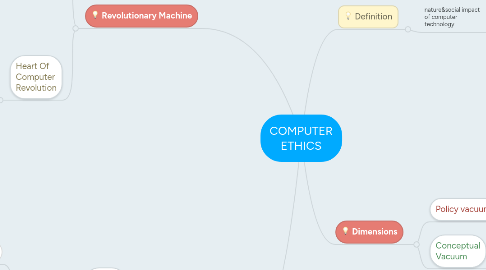
1. Invisibility Factors
1.1. Invisible Abuse
1.1.1. unethical conduct of
1.1.1.1. invisible operations
1.1.1.1.1. what policies to institute?
1.1.1.1.2. How to access the programs that lead to the operations
1.1.1.2. Invasion of property&privacy
1.1.1.2.1. Asses to confidential information
1.1.1.2.2. Altering
1.1.1.2.3. Removing
1.2. Invisible programming values
1.2.1. Biased services
1.2.2. Bugs
1.2.3. Implicit assumptions
1.3. Invisible complex calculations
1.3.1. enormous calculations
1.3.1.1. Addressing ethical dilemma
1.3.1.2. level of human trust
2. Revolutionary Machine
2.1. Anatomy of computer Revolution
2.1.1. two stages of development
2.1.1.1. Introduction stage
2.1.1.1.1. last 40 years
2.1.1.2. Permeation stage
2.1.1.2.1. Nature & value of activities
2.1.1.2.2. Transformation effect
2.2. Heart Of Computer Revolution
2.2.1. Enabling conditions
2.2.1.1. Features
2.2.1.1.1. Abudance
2.2.1.1.2. Affordability
2.2.1.1.3. Integral parts
2.2.1.2. Newness
2.2.1.2.1. smaller
2.2.1.2.2. faster
2.2.1.2.3. more powerful
2.2.2. Logical Malleability
2.2.2.1. molding the logic of computers
2.2.2.1.1. inputs
2.2.2.1.2. outputs
2.2.2.1.3. connected logical operations
2.2.2.2. limits
2.2.2.2.1. universal tool
2.2.2.2.2. human creativity
2.2.2.3. setting ethical policies in consideration of logical malleabilty
2.2.2.3.1. fully understand &address
2.2.2.4. Dimensions
2.2.2.4.1. syntax
2.2.2.4.2. Semantics
3. Definition
3.1. nature&social impact of computer technology
3.1.1. concerns of hardware
3.1.2. concerns of software
3.1.3. concerns of network
3.1.4. concerns of computer itself
4. Dimensions
4.1. Policy vacuum
4.1.1. use of computers
4.1.1.1. personal policies
4.1.1.2. social policies
4.2. Conceptual Vacuum
4.2.1. conceptual framework
4.2.1.1. nature of computer program
4.2.1.2. value preferences
